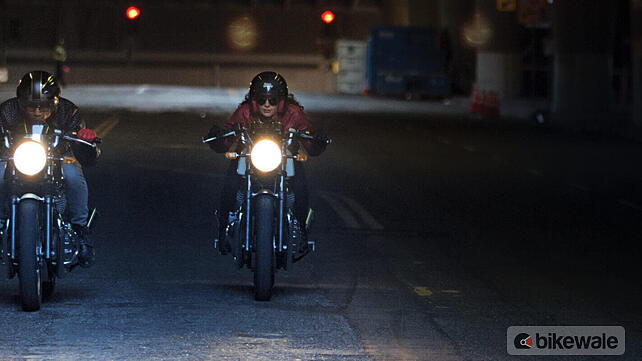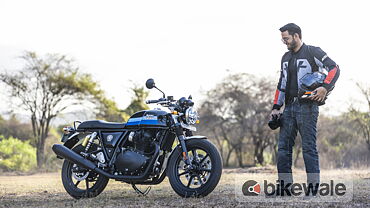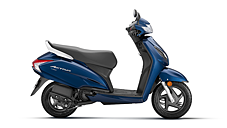Introduction

Royal Enfield sells so many motorcycles and is so profitable, everyone is scrambling to either compete or offer an alternative to the Classic 350. Royal Enfield, meanwhile, is done with the consolidation of its existing portfolio and knows that to take the next big step, it needs to do what it did in the 1990s, and undergo another big change to get to the next level. However, this time it isn’t as easy – globally, markets and manufacturers have evolved. The Himalayan was the first step in that direction, but the 650cc products are a massive leap compared to that. The first of those products we’ve swung a leg over is the Continental GT650, and here’s what we think about it.
Fact Sheet

The Continental GT650 is the sportier of the Royal Enfield twins. What differentiates it from the Interceptor 650 are the lowered handlebar and rearset footpegs, and a different seat. The rest of it remains the same: a parallel-twin 648cc air/oil cooled engine that makes 47bhp at 7250rpm and 52Nm at 5250rpm that goes through a six-speed gearbox with a slipper clutch and chain drive. Royal Enfield has settled on a 270 degree firing order and a 4 valve per cylinder configuration for the engine, to balance power and torque characteristics while retaining a passing resemblance to the thump that makes their singles so popular. Gone are the twin spark and pushrod technologies: this is a modern engine that deliberately has eschewed water cooling to keep costs in check.

The frame is a twin cradle frame. While that might not seem very high-tech, it has been developed in conjunction with Harris Performance. Seat height is at 793mm, while ground clearance is 174mm. Weight stands at 202kg, minus fuel. The tank can hold nearly 14 litres of fuel. The suspension consists of conventional 41mm forks up front, and RE has made the conscious decision to go with twin dampers at the rear, which have 5 stage preload adjustment. Brakes consist of Bybre units, a 320mm twin-piston floating disc at the front and 240mm rear disc with dual channel ABS as standard. The tyres have been specially developed by Pirelli for these products – the company didn’t have an 18” rear tyre that met RE’s requirements, so one was developed from scratch. The front is a 100/90 18 and the rear, 130/70 18.

Instrumentation consists of a twin-pod cluster with speedo and tacho taking pride of place. A small digital pod takes up real estate at the bottom of the speedo, and it displays the digital fuel gauge, odometer and twin tripmeters. The bottom of the tachometer holds the warning lamps.
On the move

The seating position on the Continental GT 650 is committed, although the handlebars contribute the lion’s share to that impression. The footpegs are rearset but not by a lot – in fact, crouching on the GT makes you feel a little cramped because then the footpegs feel like they should have been a little further back. However, for the target market, we think this riding position will be perfect, and we’re sure that mods from their performance division will include more rearset ‘pegs at some point.
The standard seat feels a little too hard for all-day rides, but it sure helps transmit all the information from the road really well. It also needs to have more grippy fabric, because you tend to slide in front every time you brake hard. This is brought into focus because the tank is a lot narrower than the engine’s crankcase – this is important because that width is what has dictated the width of the footpegs. As a result, the rider’s knees are a lot further in, and the shape of the tank doesn’t lend itself to being gripped by the rider’s knees very easily. A wider tank would have gone a long way in making the GT more comfortable – and this stems from how good the Bybre brakes and Pirelli tyres are. These tyres aren’t very wide – in fact, there are 160cc bikes with wider rear tyres in our market, but the proportions are just right on the Continental. The brakes don’t seem like much for a 650cc twin-cylinder motorcycle that weighs more than 200kg, but the bite, feel and progression on our ride was great.

The choice of suspension is interesting – the conventional front forks aren’t out of place, but twin dampers are the rear are an anachronism today, even if they help contribute to the period look of the motorcycle. Even on the smooth roads of California, the rear managed to transmit bumps to the rider – on the preload setting that was second from softest, and with a test rider that weighs almost as much as two regular Indians. For the Continental GT to work in India, the seat and suspension will both have to offer more comfort, despite its sporty intentions.
Speaking of which, the frame is such an improvement over what we’ve come to expect from a Royal Enfield. We were pleasantly surprised with what the Himalayan had to offer in terms of handling, and the Continental GT 650 is a mature handler with stiffness, compliance and feedback that puts a grin on your face. There are feeler bolts and rider footpegs with springs that can fold… this should give you an idea of what the company expects its customers will do with its new product. It isn’t the kind of motorcycle that will turn at the slightest whiff of steering input, but it forgives errors, and is ready to play. It’s a little like the engine, in fact.
The brief for the engine was to make something that had useable power through the rev range, rather than something that was a power monster that was difficult to ride daily. As a result, 80 per cent of the Continental GT 650’s torque is available from 2500rpm all the way to its power peak at 7250rpm. That’s a really wide powerband, and not just for a Royal Enfield. The 648cc parallel twin doesn’t mind being revved to the redline, but there’s no real reward to it. Instead, riding the torque curve from 3000-5000rpm works better. Yes, vibrations are present but they’re well in check. They get intrusive only when you cruise at over 100kph, which brings it to 4000rpm and over. They’re prominent through the footpegs, and to a lesser extent, through the handlebar. Vibrations from the seat aren’t absent, but they never bother the rider a lot. Fueling is smooth; even the on/off transition in the middle of a corner is handled with maturity. The gearbox is, in a word, modern. The pull on the lever is light, and it engages positively. The feel at the shift lever is excellent, with a positive snick when you go into gear. Yes, you can hurry it through the gears if you so wish, and downshifting is a breeze thanks to the back-torque limiting clutch.
The wishlist

However, there are a few things that could have made the GT a much better product. A slightly wider tank and grippier seat would have done wonders for comfort during our day-long ride. The retro instrument cluster and headlamp unit is in keeping with the retro look of the bike, but more information would have been nice – a clock is always a welcome addition, for example. Plus, the warning lamps are invisible in bright sunshine. In the same way, a clear lens headlamp would have contributed massively to the usability of the Continental in markets like India, where street lighting can be a luxury and not a given. We’re also not completely convinced about the choice of twin rear shock absorbers, and their tuning for the Indian market. Also, given it is a Royal Enfield, the company is missing out on a massive opportunity by not providing louder mufflers as an aftermarket option at the time of launch itself.
Verdict

Is there room for improvement on the Continental GT 650? Certainly. But this is a mature, modern product that will reward everyone, from a novice rider in a developed market to the born-again motorcyclist trying to relive his youth with something that looks great but isn’t too committed. Royal Enfield merely needs to get the price right. If they manage to price it in the range of Rs 3.5-3.8 lakhs, it’ll be well worth the money, but we’re expecting it to exceed that by a small margin. Watch this space.
Gallery
1/11
Royal Enfield Continental GT 650 Launch Ride Review
Double Tap to Zoom















































